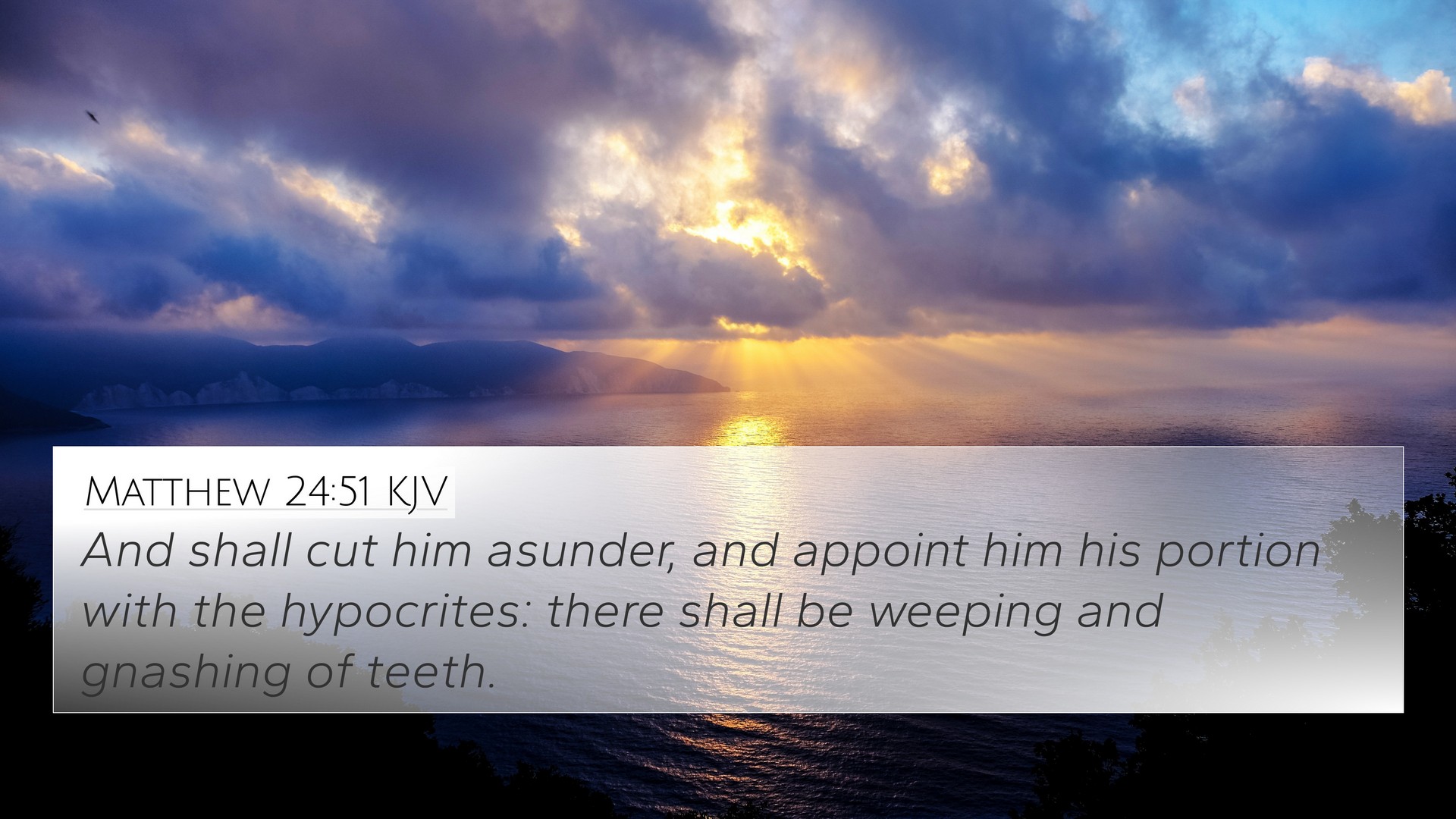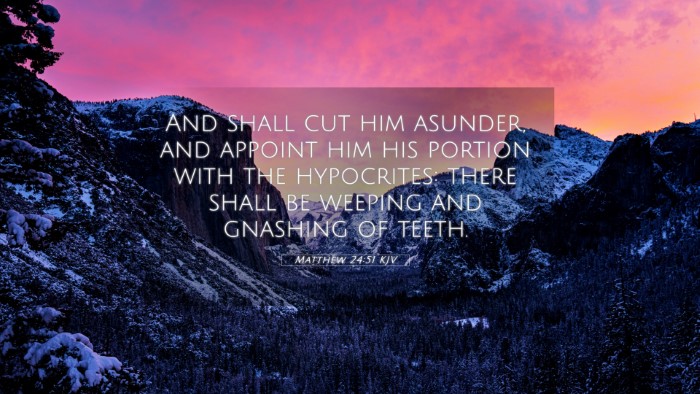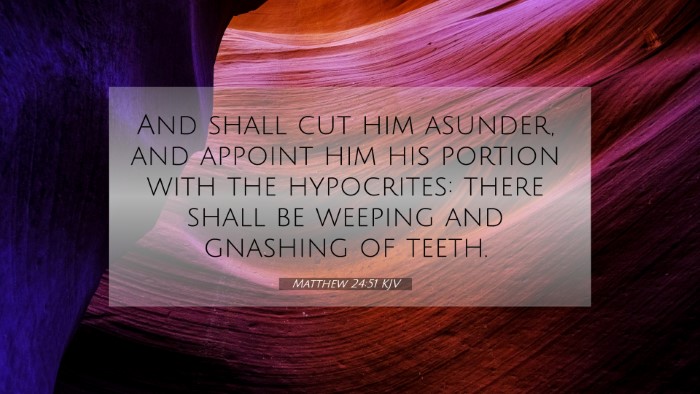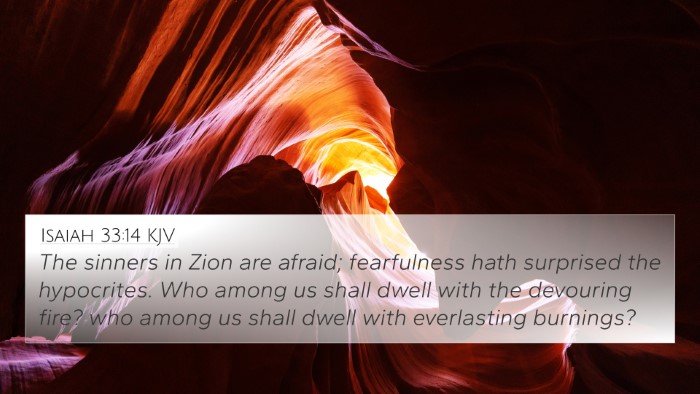Understanding Matthew 24:51
Matthew 24:51 states, "And shall cut him asunder, and appoint him his portion with the hypocrites: there shall be weeping and gnashing of teeth." This verse is part of Jesus' teachings on the end times and the importance of readiness for His return. Through a collective interpretation of public domain commentaries, we can delve deeper into the meaning and significance of this scripture.
Summary of Matthew 24:51
This verse emphasizes the dire consequences of unfaithfulness and hypocrisy. It portrays the fate of those who are unprepared for the Lord's return, highlighting a profound separation between the faithful and the unfaithful. The imagery of being "cut asunder" suggests severe judgment, while "weeping and gnashing of teeth" denotes intense sorrow and regret.
Insights from Public Domain Commentaries
Matthew Henry's Commentary
Matthew Henry explains that this verse illustrates the punishment awaiting the unfaithful servant. The "hypocrites" referred to are those who outwardly profess allegiance but inwardly reject God's commandments. The cutting asunder signifies the ultimate judgment God will exercise against those who take His grace lightly.
Albert Barnes' Notes on the Bible
Barnes notes that the term "hypocrites" is significant and speaks to the spiritual state of man who appears righteous outwardly but is corrupt internally. The language used, such as "cut him asunder," indicates a stringent action that represents divine retribution for failures to be watchful and faithful.
Adam Clarke's Commentary
Clarke emphasizes the figurative language of the text, interpreting "cut asunder" to mean that the unfaithful will be excluded from the joy of the Lord's presence. The depiction of weeping and gnashing of teeth conveys despair, a reminder to remain steadfast and vigilant in faith.
Thematic Connections and Cross-References
Matthew 24:51 resonates with several other scriptures that reinforce the themes of judgment, accountability, and the necessity of vigilance. Here are some critical cross-references:
- Luke 12:46 - "The lord of that servant will come in a day when he looketh not for him..." illustrating the consequence of being unprepared.
- 2 Peter 2:21 - "...it had been better for them not to have known the way of righteousness..." reflecting the gravity of turning away from the truth.
- Matthew 25:30 - "And cast ye the unprofitable servant into outer darkness..." which correlates closely with the theme of judgment from Matthew 24:51.
- Revelation 21:8 - "...but the fearful, and unbelieving, and the abominable..." detailing the fate of those who oppose God.
- Isaiah 66:24 - "...and they shall go forth, and look upon the carcasses of the men that have transgressed against me..." offering a vivid imagery of judgment.
- Matthew 7:23 - "And then will I profess unto them, I never knew you: depart from me..." emphasizing the need for a genuine relationship with Christ.
- 1 Thessalonians 5:2-3 - "For yourselves know perfectly that the day of the Lord so cometh as a thief in the night..." stressing readiness and vigilance.
- John 15:6 - "If a man abide not in me, he is cast forth as a branch, and is withered..." underscoring the fate of those disconnected from Christ.
- Proverbs 14:12 - "...but the end thereof are the ways of death," which ties into the final consequences of a life lived outside of God's will.
- Revelation 3:16 - "So then because thou art lukewarm, and neither cold nor hot, I will spue thee out of my mouth," echoing themes of judgment against complacency.
Conclusion
Matthew 24:51 serves as a sobering reminder of the importance of faithfulness, the reality of divine judgment, and the eternal consequences of our choices. Through comparative Bible verse analysis and thematic connections, this scripture challenges believers to evaluate their faith and remain vigilant in anticipation of the Lord's return. In studying this verse, believers might utilize various tools for Bible cross-referencing to deepen their understanding of interconnected biblical themes.
Tools for Further Study
- Bible concordance for direct word references.
- Bible cross-reference guide to explore thematic connections.
- Cross-reference Bible study methods for in-depth analysis.
- Bible reference resources to find supporting texts.
- Comprehensive Bible cross-reference materials available in libraries.
- Online tools for identifying connections between Old and New Testament.
- Mobile apps that offer features for cross-referenced themes.









